In light of the increased incidence of hateful acts against AAPIs during the COVID-19 emergency, it’s important to know what to do if you see something wrong. To address this issue, Asian Americans Advancing Justice and Hollaback! are hosting bystander intervention training sessions to equip people with the tools and knowledge they need to intervene in incidents of harassment. To register for a training session, visit their page on Bystander Intervention Virtual Trainings.
Hollaback! also has Bystander Intervention Resources, teaching the “5 Ds of Bystander Intervention.”
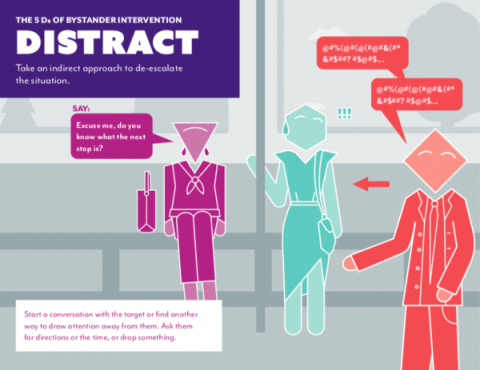
DISTRACTION is a subtle and creative way to intervene. The aim here is simply to derail the incident by interrupting it. The idea is to ignore the harasser and engage directly with the person who is being targeted. Don’t talk about or refer to the harassment. Instead, talk about something completely unrelated. You can try the following:
- Pretend to be lost. Ask for the time. Pretend you know the person being harassed. Talk to them about something random and take attention off of the harasser.
- Get in the way. Continue what you were doing, but get between the harasser and the target.
- Accidentally-on-purpose spill your coffee, the change in your wallet, or make a commotion.
Of course, read the situation and choose your Distract method accordingly. The person who is being targeted will likely catch on, and hopefully your act or statement will de-escalate the situation.
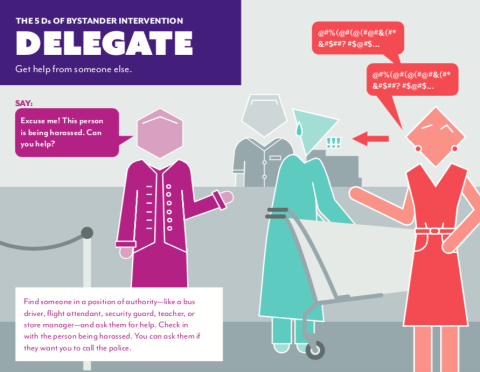
DELEGATION is when you ask for assistance, for a resource, or for help from a third party. Here are examples of what you can do:
- Find the store supervisor, bus driver, or a transit employee and ask them to intervene.
- If you’re near a school, contact a teacher or someone at the front desk. On a college campus, contact campus security or someone at the front desk of a university building.
- Get your friend on board and have them use one of the methods of Distraction (eg. asking for the time, directions, or striking up a conversation unrelated to the harassment) to communicate with the person being harassed while you find someone to delegate to.
- Speak to someone near you who notices what’s happening and might be in a better position to intervene. Work together.
- Call 311 or 911 (if it is safe) to request help. Before contacting 911, use Distract to check in with the person being targeted to make sure they want you to do this. Some people may not be comfortable or safe with the intervention of law enforcement. For many people and communities, a history of being mistreated by law enforcement has led to fear and mistrust of police interventions, and under the current climate, there are many communities, such as undocumented individuals, who may feel less safe in the hands of police. In certain situations, you may not be able to get to the person in which case, depending on the situation, you will need to use your best judgement.
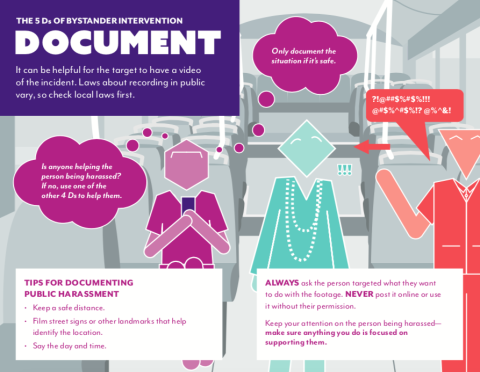
It can be really helpful to record an incident as it happens to someone, but there are a number of things to keep in mind to safely and responsibly DOCUMENT harassment. Check out this tip sheet from WITNESS for more details.
First, assess the situation. Is anyone helping the person being harassed? If not, use one of the other four D’s. If someone else is already helping out, assess your own safety. If you are safe, go ahead and start recording. ALWAYS ask the person who was harassed what they want to do with the recording. NEVER post it online or use it without their permission. There are several reasons for this. Being harassed or violated is already a disempowering experience. Using an image or footage of a person being victimized without that person’s consent can make the person feel even more powerless. If the documentation goes viral, it can lead to further victimization and a level of visibility that the person may not want. Also, posting footage without a victim’s consent makes their experience public – something that can lead to a whole host of legal issues, especially if the act of harassment or violence was in some way criminal. They may be forced to engage with the legal system in a way that they are not comfortable with. Lastly, the experience could have been traumatic. Publicizing another person’s traumatic experience without their consent is no way to be an effective and helpful bystander.
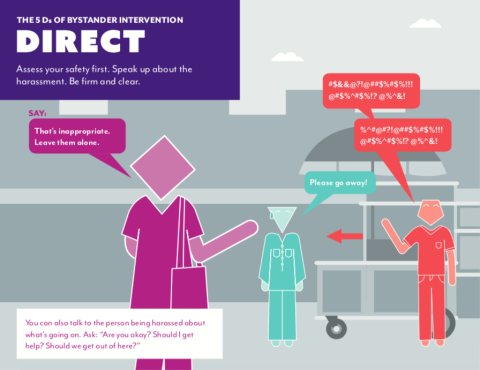
You may want to DIRECTLY RESOND to harassment by naming what is happening or confronting the harasser. This tactic can be risky: the harasser may redirect their abuse towards you and may escalate the situation. Before you decide to respond directly, assess the situation: Are you physically safe? Is the person being harassed physically safe? Does it seem unlikely that the situation will escalate? Can you tell if the person being harassed wants someone to speak up? If you can answer yes to all of these questions, you might choose a direct response.
If you choose to directly intervene, some things you can say to the harasser are:
- “That’s inappropriate, disrespectful, not okay, etc.”
- “Leave them alone.”
- “That’s homophobic, racist, (insert type of harassment), etc.”
The most important thing here is to keep it short and succinct. Try not engage in dialogue, debate, or an argument, since this is how situations can escalate. If the harasser responds, try your best to assist the person who was targeted instead of engaging with the harasser.
Direct intervention can be risky, so use this one with caution.
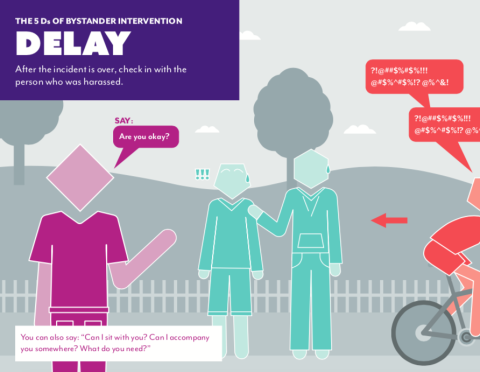
Even if you can’t act in the moment, you can make a difference for the person who has been harassed by checking in on them after the fact. Many types of harassment happen in passing or very quickly, in which case you can wait until the situation is over and speak to the person who was targeted then. Here are some ways to actively use the tactic of DELAY:
- Ask them if they’re okay and tell them you’re sorry that happened to them.
- Ask them if there’s any way you can support them.
- Offer to accompany them to their destination or sit with them for awhile.
- Share resources with them and offer to help them make a report if they want to.
- If you’ve documented the incident, ask them if they want you to send it to them.
* A note about safety: We don’t ever want you to get hurt trying to help someone out. Always think about safety and consider possibilities that are unlikely to put you or anyone else in harm’s way.

